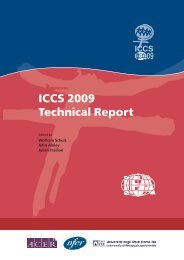Teacher Education and Development Study in Mathematics - IEA
Teacher Education and Development Study in Mathematics - IEA
Teacher Education and Development Study in Mathematics - IEA
You also want an ePaper? Increase the reach of your titles
YUMPU automatically turns print PDFs into web optimized ePapers that Google loves.
136<br />
TEACHER PAY AND STUDENT MATHEMATICS ACHIEVEMENT<br />
<strong>Teacher</strong> salaries <strong>and</strong> workload<br />
Primary <strong>and</strong> secondary school teachers <strong>in</strong> the Philipp<strong>in</strong>es have similar salary schedules.<br />
A teacher with a m<strong>in</strong>imum teach<strong>in</strong>g qualification earns roughly 2.05 times the GDP per<br />
capita as a start<strong>in</strong>g salary, 2.26 times the GDP per capita after 15 years of experience,<br />
<strong>and</strong> 2.43 times the GDP per capita after 30 years of experience (UNESCO Institute for<br />
Statistics, 2006). A teacher with maximum qualifications <strong>and</strong> 30 years of experience<br />
earns a salary that is 3.66 times the GDP per capita (UNESCO Institute for Statistics,<br />
2006). In terms of <strong>in</strong>ternational PPP dollars, the average salary for a primary or<br />
secondary school teacher with m<strong>in</strong>imum qualifications is $9,418 if that teacher has<br />
no years of experience, $10,396 if he or she has 15 years of experience, $11,195 if he or<br />
she has 30 years of experience, <strong>and</strong> $16,833 if he or she has 30 years of experience <strong>and</strong><br />
maximum qualifications (UNESCO Institute for Statistics, 2006). To move from the<br />
m<strong>in</strong>imum to the maximum salary, teachers need to have been teach<strong>in</strong>g, on average, for<br />
22 years (UNESCO Institute for Statistics, 2006).<br />
Agarao-Fern<strong>and</strong>ez <strong>and</strong> Guzman (2005) note that a public school teacher’s maximum<br />
salary is only P10,000, well under the National Economic <strong>and</strong> <strong>Development</strong> Authority’s<br />
basic liv<strong>in</strong>g st<strong>and</strong>ard of P16,710 for an average family. <strong>Teacher</strong>s, they observe, may not<br />
only experience difficulty meet<strong>in</strong>g their basic household needs but also have to purchase<br />
their own teach<strong>in</strong>g materials. F<strong>in</strong>ally, teachers generally receive non-wage benefits <strong>and</strong><br />
bonuses only if their work is outst<strong>and</strong><strong>in</strong>g or if they obta<strong>in</strong> higher education degrees<br />
beyond the basic requirement (UNESCO Institute for Statistics, 2006). <strong>Mathematics</strong><br />
<strong>and</strong> science teachers do not seem to earn additional benefits or bonuses, even though<br />
they are generally <strong>in</strong> shorter supply. In the Philipp<strong>in</strong>es (as <strong>in</strong> other countries), teachers<br />
are not paid on the basis of the subjects they teach but accord<strong>in</strong>g to the level of the<br />
education system they teach, that is, primary, secondary, or tertiary.<br />
To compound the salary issue, teachers <strong>in</strong> the Philipp<strong>in</strong>es face a heavy workload <strong>in</strong><br />
terms of work hours <strong>and</strong> class sizes. Primary <strong>and</strong> lower-secondary school teachers are<br />
required to work 196 days out of the school year for 30 hours per week, while uppersecondary<br />
teachers are required to work 25 hours per week. However, the number of<br />
hours each year that teachers <strong>in</strong> the Philipp<strong>in</strong>es teach is considerably more than the<br />
hours taught by their colleagues <strong>in</strong> most other East Asian countries (UNESCO Institute<br />
for Statistics, 2006).<br />
In 1998, the <strong>Teacher</strong> <strong>Education</strong> Commission broke down the weekly teach<strong>in</strong>g load of<br />
a typical teacher <strong>in</strong> the Philipp<strong>in</strong>es as follows: 20 hours of actual teach<strong>in</strong>g, 15 hours of<br />
preparation <strong>and</strong> grad<strong>in</strong>g, <strong>and</strong> 10 hours on other tasks. Accord<strong>in</strong>g to the commission,<br />
teachers at this time were work<strong>in</strong>g more than the 40-hours-per-week civil-service<br />
requirement (<strong>Education</strong> Commission, cited <strong>in</strong> Agarao-Fern<strong>and</strong>ez & Guzman, 2005).<br />
From what we underst<strong>and</strong>, the situation is much the same today. Furthermore, class sizes<br />
<strong>in</strong> both primary <strong>and</strong> secondary schools are relatively large, with an average of 42 students<br />
per class <strong>in</strong> the former <strong>and</strong> 36 <strong>in</strong> the latter <strong>in</strong> 2004 (UNESCO Institute for Statistics,<br />
2006). Many classes <strong>in</strong> urban areas have 60 to 75 students. These large numbers very<br />
likely act as a further deterrent to anyone consider<strong>in</strong>g enter<strong>in</strong>g mathematics teach<strong>in</strong>g.<br />
We estimated <strong>and</strong> compared the salaries of teachers with the salaries of two other<br />
occupations for two years, 2001 <strong>and</strong> 2006. Our estimates suggest that both male <strong>and</strong><br />
female teachers are paid better than university graduates who are not scientists, but

















